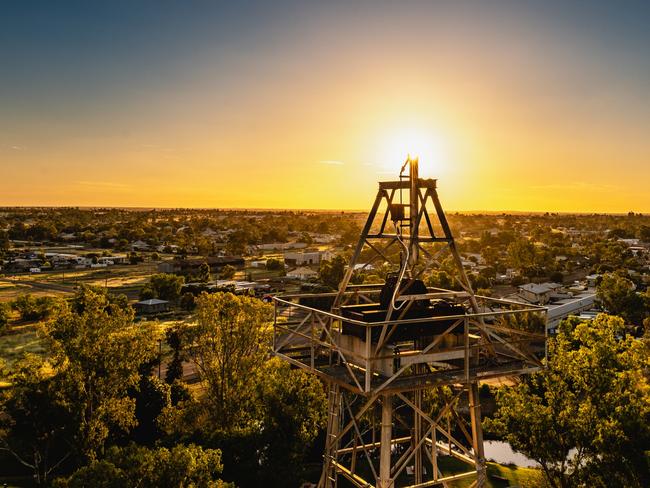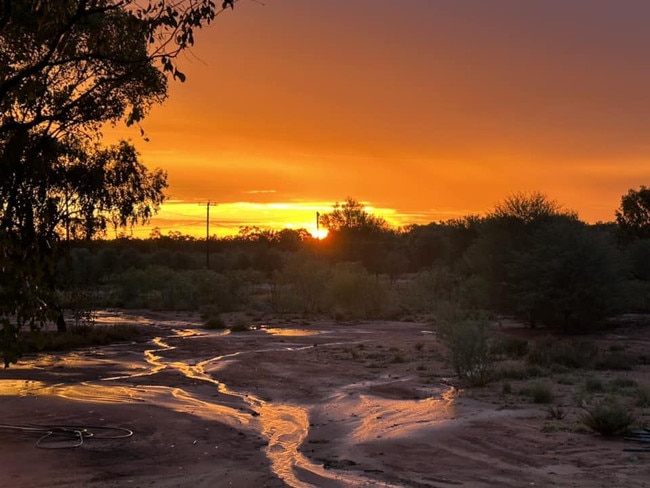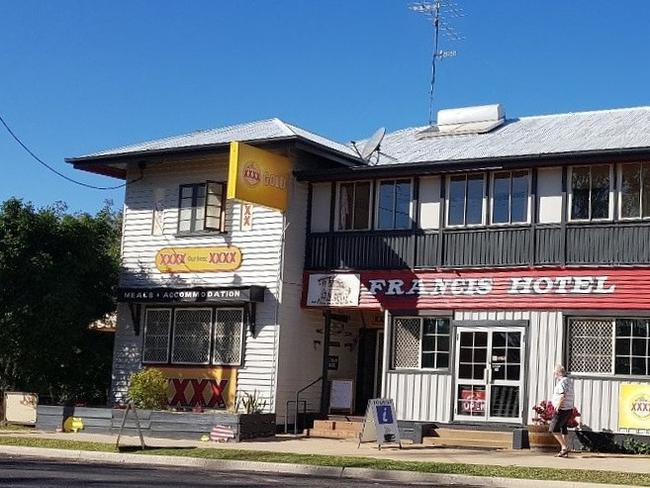Tourist guide: How you can help flood affected towns with tourism
Tourists looking to take a break are being urged to support outback towns by holidaying in western Qld as they aim to recover from devastating flooding. Check out our five day guide for exploring the region.
Community News
Don't miss out on the headlines from Community News. Followed categories will be added to My News.
Western Queensland residents reeling after record flooding are urging tourists to check out their beautiful region and provide a cash injection for struggling communities.
From wild rodeos, sprawling heritage trails, stunning watering holes and hot springs and historical sites and museums there is something for everyone out west.
For regulars to the region or those wanting to visit the outback for the first time, we’ve put together a five day itinerary to soak in the beauty of western Queensland while helping those affected by the floods.

Day 1 (Toowoomba – Roma: Four hours)
What to do: The administrative centre of the Maranoa Region there is no shortage of things to do and see around Roma. Home to the largest cattle saleyards in Australia, with more than 400,000 cattle passing through a year, the Roma Saleyards are a magnificent site for tourist looking to learn more about outback life. Enjoy the state-of-the-art interpretative centre and learn the story of Roma’s cattle industry.
For revheads why not check out Up The Creek Garage, where you can enjoy their massive display of classic cars and rusty relics, learn about the history of farming around Roma from fifth generation locals and see their Texas longhorns.
For those wanting to wash off the outback dust take a drive to the Great Artesian Spa in Mitchell. Take a swim in the mineralised waters and enjoy a coffee from the nearby cafe. A town full of rich history, tourists can check out the Avenue of Heroes – Roma’s tribute to the servicemen lost during the World War I, visit The Big Rig Oil & Gas Museum or take a self- guided walk featuring Roma’s most historical oil and gas industry sites along the Hospital Hill Heritage Walk.
Where to stay: Ups and Downs Caravan Park located 8km from Roma provides guests with an authentic farm stay experience complete with all the creatures comforts. Take a stroll around the 200 acre property, meet the four legged residents and enjoy a wine by the fire pit at the 4.30pm happy hour.
What to eat/drink: For the best coffee in town check out ReX Coffee + Food, for a nice breakfast out with the family why not visit Beck’s Chopping Board, for those looking for a hearty dinner head to the Explorers Inn for a juicy steak or the Yuleba Hotel for a delicious burger.

Day 2 (Roma – Charleville: Three hours)
What to do: The largest town in western Queensland, Charleville is the gateway to the outback. For those who have looked to the stars and wondered what secrets they hold check out the Charleville Cosmo Centre. Immerse yourself in Queensland’s largest planetarium, view the sun through specialised telescopes and check out the tapestry of stars painted across the outback sky at night.
For history buffs visit Charleville’s WWII Secret Base, an interactive exhibition centre which homed 3500 United States Army Air Force personnel in 1943.
Take part in the Charleville Bilby Experience, tour the nocturnal house and get up close and personal with the cute and endangered bilbies.
Where to stay: Located 8km west of Charleville, the 33,000 acre rangeland grazing property Evening Star Tourist Caravan Park is the best place to view the skies with Venus shining its brightest from there. Ten kilometres east of Charleville is The Rock Pool, a site with acres of flat area for camping and a rock quarry perfect for yabbying.
What to eat/drink: For coffees and breakfast check out the Milk Bar on Alfred, for great outback Australia dinner options visit On The Rocks and for a great pub meal and a beer check out the historical Hotel Corones.

Day 3 (Charleville – Quilpie: Two hours)
What to do: Heading deeper into the outback we come upon Quilpie, a town severely impacted by the flooding and in dire need of tourism dollars. A stunning location Quilpie is now adorned with native flowers after the flooding, a once in a lifetime sight.
Take a drive out to Adavale, north of Quilpie, and with a population of just 15 people it’s a hidden gem and home to great fishing spots, birdwatching and the stunning Hell Hole Gorge National Park. The town also homes historical relics of the early settlers who battled the harsh conditions.
Heading west from Quilpie visitors will come upon Eromanga. The furthest town from the sea in Australia, Eromanga is known for its significant palaeontological discoveries with Australia’s largest dinosaur discovered on a property near Eromanga. Several dinosaurs have been unearthed and the bones are now displayed in the Eromanga Natural History Museum.
Why not stop into the The Old Royal Hotel on Saturday for a community barbecue, built in 1885 the hotel is one of the oldest in Australia.
Where to stay: For those looking to camp in Quilpie you can’t go past the beautiful ‘The Lake’ site. Located on the banks of the stunning Lake Houdraman, 4km east of Quilpie ‘The Lake’ offers a unique farm stay with a variety of accommodation options.
For those wanting to be among the action book a room in the Quilpie Brick Hotel. Built in 1926 the Brick Hotel, formerly known as the Quilpie Hotel and known to locals as ‘the Brick’, is one of the oldest buildings in Quilpie and is the quintessential outback pub.
What to eat/drink: Home to some great outback eateries with some cracking steaks check out the Hotel Imperial Restaurant and South Western Hotel – Toompine Pub. For a fun high tea experience visit Adavales’ Elegant Emu.

Day 4 (Quilpie – Cunnamulla: Three hours)
What to do: Heading southeast from Quilpie visitors will come upon Cunnamulla and guarding the entry to the town the famous Cunnamulla Fella. The massive statue is a tribute to the Aussie larrikin stockman portrayed in the Stan Coster and Slim Dusty song.
Visit the sprawling Warrego River, go kayaking, fishing, swimming, enjoy a picnic by the banks and keep an eye out for native birds and the Cooper Creek turtle.
Take a walk through the 6km Cunnamulla Bushlands and check out Cunnamulla War Memorial at the town’s centre`. Visit the nearby Eulo, one of the densest Megafauna fields in Australia. Visit the Eulo Queen hotel, checkout the local honey and bees wax products, visit the Lizard Lounge, the life size Diprotodon statue, the Bilby Burrow art and craft gallery, and experience a hot artesian mud bath.
Where to stay: Located in the centre of Town the Hotel Cunnamulla provides a range of room options above the famous pub. Fifty kilometres east of Cunnamulla check into Charlotte Plains, the world famous sheep station features hot artesian baths and a variety of camping options. For more bush camping we recommend Francvillers Station a genuine outback experience on vast outback country.
What to eat/drink: Visit Cunnamulla’s ‘Rumour Has It’ cafe for great food and a cute gift shop with a range of gifts and homewares, clothing, shoes and man cave accessories. For great pub feeds visit Hotel Cunnamulla and Billabong Hotel Motel Bistro and for fresh bread and baked treats check out the Cunnamulla Bakery.

Day 5 (Cunnamulla – St George: Three hours)
What to do: Heading back towards Toowoomba visitors will reach the St George region. Home to the seven unique towns of St George, Bollon, Dirranbandi, Hebel, Mungindi, Nindigully and Thallon there is something for everyone to enjoy.
Visit the Thrushton and Culgoa Floodplain National Parks and join the Cotton Farm and Winery Tours getting an insider’s view of a working cotton farm before heading to Queensland’s most western vineyard. To enjoy the mighty Balonne River, take a trip on board a Sandytown River Cruise.
Where to stay: There are a dozen fantastic camping and caravan sites across the region from Balonne Minor Free Camp, Hebel General Store and Caravan Park and Kapunda Riverfront Tourist Park all providing the opportunity for visitors to get out and about in nature. For those looking for backpacker accommodation, Blenheim Backpackers offers comfortable accommodation for seasonal workers during the cotton, grape, rockmelon, pumpkin, and grain harvest just 1.8km from St George’s main street.
What to eat/drink: Stop by any of the amazing pubs on offer in St George including the St George Hotel Motel, Australian Motel Hotel and the Cobb and Co Hotel. For coffees and cakes check out the Delicate Cafe and The Farmhouse Cafe.
Day 6 (St George – Toowoomba: Four hours)
What to do: Heading back to Toowoomba why not stop over at the Thallon pub. Recently in the news for offering free beers for the return of glasses the pub boasts great food, cold beers and a great country feel. While you’re there make sure to check out the Thallon Silos, adorned with a massive mural of Australian wildlife.
Continue the art tour into Goondiwindi and check out Bowen Lane in the town’s CBD, where you can find painting by local and interstate artists, like Kate Owen. Home to 12 unique pubs there is also no shortages of places to wet your whistle.
Make sure to check out the Texas Rabbit Works before you leave, a historic site which kept families employed throughout the Great Depression.
Wave goodbye to western Queensland and take with you memories to last a lifetime and the knowledge you’ve done your part to help flood affected towns get back to their feet.




